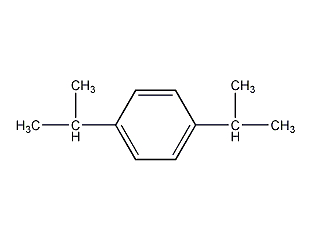
Structural formula
| Business number | 02HD |
|---|---|
| Molecular formula | C12H18 |
| Molecular weight | 162.27 |
| label |
1,4-diisopropylbenzene, 1,4-diisopropylbenzene, p-Dicumylbenzene, p-diisopropylbenzene, C6H4[CH(CH3)2]2, 1,4-Diisopropylbenzene, P-Diisopropylbenzene, 1,4-Bis(1-methylethyl)-benzen, 1,4-Bis(1-methylethyl)benzene, 1,4-Bis(1-methylethyl)-Benzene, 4-Isopropylcumene, Benzene, 1,4-di-(1-methylethyl), Benzene, p-diisopropyl- |
Numbering system
CAS number:100-18-5
MDL number:MFCD00008892
EINECS number:202-826-9
RTECS number:CZ6360000
BRN number:1854739
PubChem number:24863977
Physical property data
1. Properties: colorless liquid.
2. Density (g/mL, 20℃): 0.8568
3. Relative vapor density (g/mL, air=1): 5.6
4. Melting point (ºC): -17
5. Boiling point (ºC, normal pressure): 210.3
6. Liquid phase standard hot melt (J·mol-1 ·K-1): 314.5
7. Refractive index (n20): 1.4898
8 . Flash point (ºC): 76
9. Specific rotation (º): Undetermined
10. Autoignition point or ignition temperature (ºC): Undetermined
11. Vapor pressure (mmHg, 20ºC): 0.25
12. Solubility parameter (J·cm-3)0.5: 16.930
13. van der Waals area (cm2·mol-1): 1.404×1010
14. van der Waals volume (cm3·mol-1): 101.000
15. Critical pressure (KPa): Undetermined
16. Log value of oil-water (octanol/water) partition coefficient: Undetermined
17. Explosion upper limit (%, V/V): Undetermined
18. Lower explosion limit (%, V/V): Undetermined
19. Solubility: Undetermined
Toxicological data
Acute toxicity: Unknown via rat LD50: 11540mg/kg; Mouse oral LD50: 3400mg/kg; Mouse peritoneal cavity LD50: 1650mg/kg;Unknown LD50 in mice: 7980mg/kg;
Ecological data
This substance may be harmful to the environment. It is recommended not to let it enter the environment. It may cause pollution to water bodies and the atmosphere.
Molecular structure data
1. Molar refractive index: 54.62
2. Molar volume (cm3/mol): 189.5
3. Isotonic specific volume (90.2K ): 437.3
4. Surface tension (dyne/cm): 28.3
5. Dielectric constant: 2.30
6. Dipole moment (10-24cm3):
7. Polarizability: 21.65
Compute chemical data
1. Reference value for hydrophobic parameter calculation (XlogP): None
2. Number of hydrogen bond donors: 0
3. Number of hydrogen bond acceptors: 0
4. Number of rotatable chemical bonds: 2
5. Number of tautomers: none
6. Topological molecule polar surface area 0
7. Number of heavy atoms: 12
8. Surface charge: 0
9. Complexity: 100
10. Number of isotope atoms: 0
11. Determine the number of atomic stereocenters: 0
12. Uncertain number of atomic stereocenters: 0
13. Determine the number of chemical bond stereocenters: 0
14. Number of uncertain chemical bond stereocenters: 0
15. Number of covalent bond units: 1
Properties and stability
Avoid contact with strong oxidizing agents.
Storage method
Store in a cool, ventilated warehouse. Keep away from fire and heat sources. should be kept away from oxidizer, do not store together. Equipped with the appropriate variety and quantity of fire equipment. The storage area should be equipped with emergency release equipment and suitable containment materials.
Synthesis method
None yet
Purpose
Used in organic synthesis.

 微信扫一扫打赏
微信扫一扫打赏

